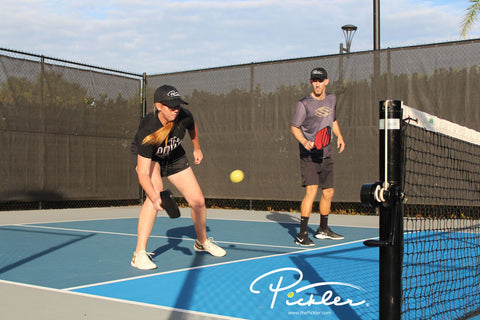You have heard it before… most points are won at the Non-Volley Zone line. It is important to get to the Non-Volley Zone line and then hold that line. But, how do you do that? How do you work with your partner in doubles pickleball to win at the Non-Volley Zone line?
Try these 7 tips to win more points with your partner at the Kitchen line:
- Move as a Team – When playing doubles in pickleball, you must work with your partner as a team. If you do not work with your partner as a team, then you will not win. Generally, you and your partner will always be about six to eight feet apart at the Kitchen line. Think about it as if there were a six- to eight-foot string attaching you to your partner. If you move, your partner should move. If your partner moves, then you should move.

- Stay at the Line – Hold the line as much as possible. If you are forced back or need to take a step back off of the line to handle pace from your opponents, immediately step back in and remain in tandem. Hold the line, and avoid breaking the tandem with your partner and playing at different depths of the pickleball court.

- Follow the Flight of the Pickleball – You and your partner should follow the flight of the pickleball at the Non-Volley Zone line. For example, imagine you hit a crosscourt forehand dink to your opponent. Your partner should follow the pickleball and cover the line, and you should follow the pickleball and squeeze the middle of the court, remaining within six to eight feet of your partner. If your opponents return the pickleball to your partner and your partner hits a crosscourt backhand dink to your opponent, then you should follow the pickleball back to the line on your side of the pickleball court, and your partner should follow the pickleball and now squeeze the middle of the court; again, remaining within six to eight feet of you. Follow the flight of the pickleball to limit your opponents’ angles of attack on the pickleball court.
- Give Up Part of the Court – By staying linked with your partner (about six to eight feet away), and following the flight of the pickleball, then you and your partner will only cover two-thirds to three-quarters of the court at any time. You and your partner will be “giving up” a portion of the court. This is okay and actually good strategy, as the portion that you will “give up” represents low percentage shots (in other words, difficult shots with a high margin of error). Your opponents will have a low chance of hitting a winner if they decide to go for a shot in this area. And, even if your opponents go for a shot in this area, you will still have the ability to move and track down those shots.

- Communication Is a Must – If your opponents’ hit the pickleball down the middle of your side of the court, both you and your partner could go after the pickleball. However, you and your partner will have the potential of crashing into each other and smashing paddles. In light of this, communication is essential to winning doubles pickleball. Communicate with your partner on the pickleball court—“Mine.” “Me.” “You.” “I got it.” “Yours.” This is particularly true if a left-handed player and a right-handed player are partnered together, as either both forehands or both backhands will be in the middle—making communication even more important.
- Forehands Preferred in the Middle – Since forehand shots are generally stronger and more consistent than backhand shots, the rule of thumb is for the player with the forehand down the middle to take the shots that are down the middle. And, to note, if a left-handed player and a right-handed player are partnered together, it will be important to discuss and agree upon who takes preference in the middle when both forehands are in the middle, as well as when both backhands are in the middle, of the court.

- Cover More Court If Out of Position – At times, your opponents may hit a good shot that takes you or your partner out of position. Or, maybe your partner goes for an Erne that your opponents are able to hit back to your side of the pickleball court, which, again, puts you and your partner out of position. When this happens, your partner will likely be wide and off the court, while you will remain on the court (or vice versa). If your partner is pulled wide, it is important for you to move toward the middle and try to cover more of the pickleball court until your partner can regain position. To note, try to slow the pickleball down with a drop, dink, or lob to give you and your partner more time to regain position before your opponents can hit the next shot.
Use these tips to work better as a team at the Non-Volley Zone line and win more points!
WANT MORE PICKLEBALL TIPS AND STRATEGIES?
Learn the #1 tip from the pro pickleball players!

Plus, if you want more pickleball tips and strategies on every aspect of your pickleball game, check out Pickler’s online video lesson collection called My Pro Pickleball Coach. My Pro Pickleball Coach is a fraction of the price of one clinic or even one lesson, and features over 140 video lessons (over 7 hours of instruction!), as well as a corresponding e-book. These online video lessons are available on demand 24/7 and breakdown every aspect of the sport of pickleball, including pickleball drills, strategy, and advanced concepts, so you will play your best pickleball.





